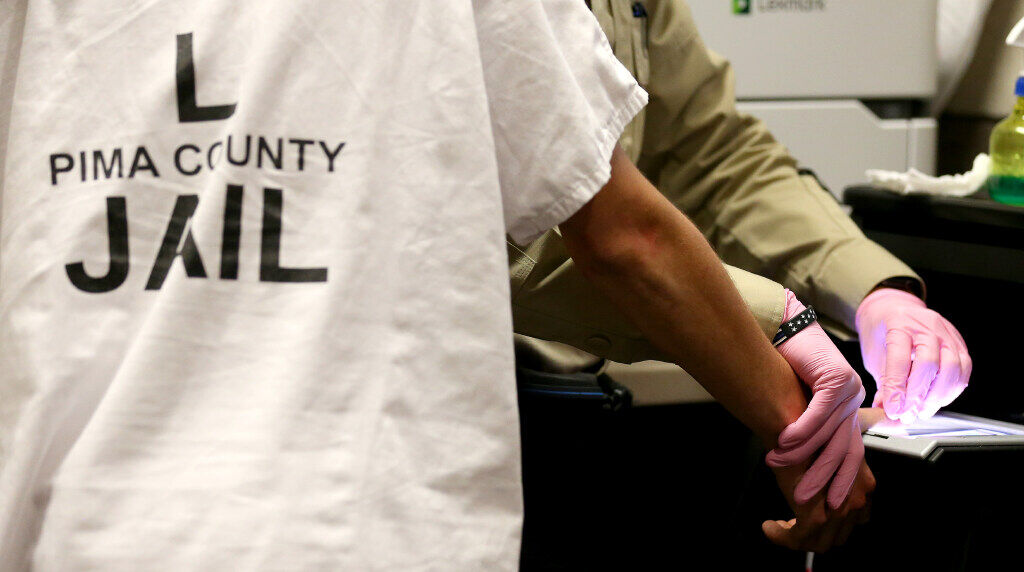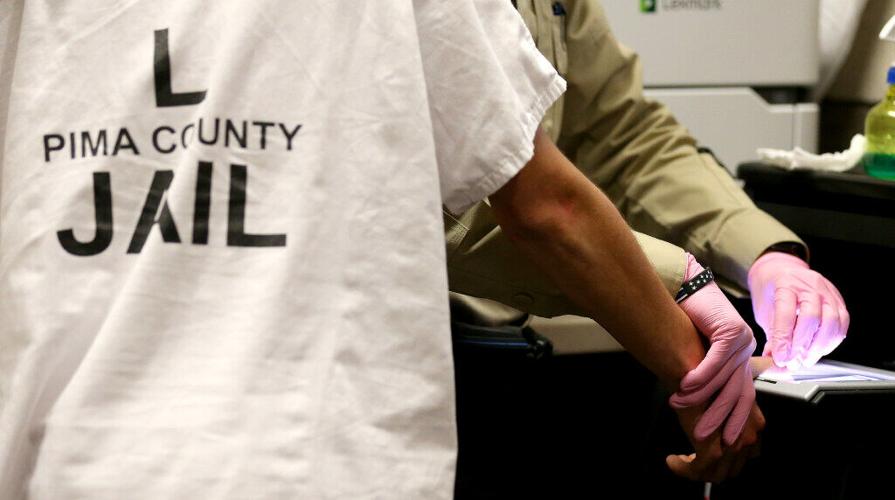Twice a day, new arrivals at the Pima County jail are escorted into a room where they sit in front of a webcam and find out whether theyŌĆÖll be released or kept in jail while their court cases proceed.
On the other end of the webcam, a Tucson City Court judge assesses arresteesŌĆÖ charges and, in most cases, only takes a few minutes to make a decision.
These initial appearances are the first hearings defendants attend after theyŌĆÖre arrested. Cases are heard by city of Tucson magistrates regardless of where defendants were arrested under a process established 15 years ago. The agreement between the city of Tucson, Pima County and their court systems consolidated judicial coverage of the hearings throughout the county.
Now, the courts are asking for a 10-year renewal of that agreement, but major players in the countyŌĆÖs criminal justice system are calling for changes. Present and past officials from the Pima County AttorneyŌĆÖs Office have cited a lack of consistency in rulings resulting in a lack of parity afforded to defendants.
People are also reading…
The Pima County Board of Supervisors is set to vote Tuesday, May 3, on the intergovernmental agreement, or IGA, that consolidates the initial appearance process and allows city magistrates to oversee them.
The board has delayed voting on the issue three times after hearing from representatives of the countyŌĆÖs court systems, the county attorney and public defender.
Pima County Attorney Laura Conover has tied the conversation around initial appearances to issues within the cash bail system, where a judge issues a bond at an initial appearance that makes a defendantŌĆÖs release contingent on their ability to pay, while suggesting the magistrates need more training.

Pima County Attorney Laura Conover: ŌĆ£What I'm hoping we won't see anymore is just the wild swing of if you are arrested on a Monday night, you're gonna get one outcome, and if you're arrested on a Tuesday night, it's a wildly different analysis that occurs.ŌĆØ
The cash bail system ŌĆ£houses people on low cash bail who have no business being in the Pima County Jail; itŌĆÖs not a hospital,ŌĆØ Conover told the board, adding that the system ŌĆ£frees peopleŌĆØ released on bail who reoffend and lets them ŌĆ£go back out and finish what they started.ŌĆØ
Top court officials disagree, saying the initial appearance process is efficient. The city magistrates do ŌĆ£an exceptionally good job,ŌĆØ Jeffrey Bergin, Pima County Superior CourtŌĆÖs presiding judge, told the board.
ŌĆ£The IGA thatŌĆÖs before you is not a bail reform document. Bail reform is a separate issue. ItŌĆÖs a legislative issue, primarily,ŌĆØ Bergin said. ŌĆ£What the IGA does is it allows us to timely, efficiently and fairly see people in their initial appearance.ŌĆØ
More experienced judges
City magistrates have overseen initial appearances since 2007. The agreement was renewed in 2019 and expired in June 2021, but the process still operates under its parameters.
The judge must see the arrestee within 24 hours after arrest and decide the conditions of release, which range from being let out of jail without monitoring to being issued high-dollar bond amounts that keep an individual in jail until paid.
Conover suggested the countyŌĆÖs current initial appearance process produces different outcomes as judges have differing levels of felony experience, and therefore take different approaches to issue release conditions.
She suggested to the board that the initial appearance process be overseen by Superior Court judges ŌĆ£or at the very least a return to deeply experienced felony-level judges.ŌĆØ
ŌĆ£What IŌĆÖm hoping we wonŌĆÖt see anymore is just the wild swing of if you are arrested on a Monday night, youŌĆÖre gonna get one outcome, and if youŌĆÖre arrested on a Tuesday night, itŌĆÖs a wildly different analysis that occurs,ŌĆØ Conover said. ŌĆ£I know this as the county attorney because I have spent many a night and morning observing the disparities.ŌĆØ
The uneven results actualize by race, Conover said.
According to data from her office, from 2017 to 2022, the average bail amount set for those charged with nonviolent offenses was $1,684. For Hispanic defendants, average bail was nearly 14% higher than this, and about 11% lower for white defendants. Black defendants were issued bonds about 4% lower than the average.
For violent offenses, the average bail was $15,779. The bail amount decreases by about 2% for Hispanics and 15% for white defendants. For Black defendants, the average bail for violent offenses was $20,636, a 31% increase from the average.
Conover sent suggested changes to the IGA in an April 14 email to the countyŌĆÖs court officials and supervisors. They include requiring judges assigned to initial appearances to have at least three years of felony prosecution or criminal defense experience.
The suggested changes also include requiring city magistrates to consider release conditions that donŌĆÖt impose bail if the judge finds the arrestee ŌĆ£is not a continuing danger to the community.ŌĆØ
ConoverŌĆÖs office announced for the release conditions it suggests to judges during initial appearances, which include considering if those charged with felonies pose an ŌĆ£ongoing threat of harm to the community.ŌĆØ
But Bergin said thereŌĆÖs no data to support the need for more experienced judges and takes issue with the suggestion the countyŌĆÖs judicial system should blur its independent lines by implementing policies from a separate branch of the justice system.
Conover said she ŌĆ£doesnŌĆÖt want to tread too far into the separate powers of the bench,ŌĆØ but that her experience overseeing initial appearances has led her to call for change beyond her own office.
ŌĆ£ItŌĆÖs incumbent upon me to offer, I think, some amendments to the IGA that would really improve quality and performance,ŌĆØ she said.
The initial appearance
Twelve city magistrates conduct initial appearances, some on a pro-tem, or temporary basis, to substitute for full-time judges who are unavailable, said Tony Riojas, Tucson City CourtŌĆÖs presiding judge.
Of the eight full-time magistrates, five have prior felony experience, according to Riojas, who added that all four pro-tem judges are retired, and two have experience with felonies beyond the bench.
Riojas oversees eight initial appearance sessions within a four-week rotation where judges are scheduled to handle the hearings. HeŌĆÖs one of three judges in Arizona who train judges presiding over initial appearances.
When new magistrates are brought on, theyŌĆÖll watch ŌĆ£a coupleŌĆØ of initial appearance sessions, sitting behind the bench with the judge. When they feel comfortable, the new magistrate will preside over a hearing with a more experienced judge watching, Riojas said.
Initial appearance judges must adapt to the fast-paced setting of the hearings, where dozens of individualsŌĆÖ release conditions could be determined within an hour. Riojas said the majority of cases the judges oversee are felonies.
ŌĆ£If I spend more than five minutes on a case, IŌĆÖm taking a long time,ŌĆØ Riojas said. ŌĆ£YouŌĆÖve already got all the information youŌĆÖre gonna get, so you just have to process and decide what to do.ŌĆØ
The magistrate considers information including the arresting agencyŌĆÖs probable cause that a crime was committed and input from the county attorney and public defender.
A key part of the input considered is a report from Pretrial Services, a division of Pima County Superior Court that assesses defendantsŌĆÖ eligibility for release.
Pretrial Services interviews those booked into jail, looks into their criminal history and completes a ŌĆö a nine-factor scoring system used to predict an individualŌĆÖs likelihood of committing a violent offense, appearing for their next court date and being rearrested.
Pretrial Services recommends release conditions for arrestees based on this analysis, which is a suggestion judges do not have to follow, but do about 80% of the time, said director Domingo Corona.
Those release conditions range from release without monitoring, release with supervision from a Pretrial Services officer and imposing bail amounts an individual must pay before release.
ŌĆ£WeŌĆÖre not in the business of predicting human behavior. So we canŌĆÖt say what someoneŌĆÖs going to do once they get released,ŌĆØ Corona said. ŌĆ£So I think that collaborative process, when it comes to the bail decision, is helping support the judgeŌĆÖs role at (initial appearances).ŌĆØ
Another key party involved in the process is the public defender, who represents defendants at their initial hearings and may provide further input on their alleged crimes.
Joel Feinman, whose last day as Pima County Public Defender was Monday, agrees with BerginŌĆÖs assertion that city court magistrates are not the issue. Feinman presented his thoughts to the board two weeks after it heard comments from several judges and the county attorneyŌĆÖs office.

Pima County Public Defender Joel Feinman said the issue with the initial appearance process is not the experience of magistrates, but the tendency to hold people in jail on past failure-to-appear charges.┬Ā
ŌĆ£What my department sees as the problem, or one of the problems, is that people are being held on misdemeanors,ŌĆØ he told supervisors.
Magistrates often hold arrestees in jail after initial appearances for failure-to-appear warrants issued by other city court judges in past cases. Feinman said this is due to an ŌĆ£understandable tendency to keep defendants in jail on (failure-to-appear) warrants issued by their colleagues.ŌĆØ
According to Feinman, his office tracked all initial appearance hearings from April 5-19 and found 109 defendants were held in jail on misdemeanor warrants.
ŌĆ£These are people who committed some very low-level misdemeanor offense in Tucson City Court ... and they did not show up in court for their appearance,ŌĆØ Feinman said.
The judges at both the county and city levels also highlight defendantsŌĆÖ past failures to appear at their court hearings as a key issue but say itŌĆÖs part of the criminal history they must consider when making decisions.
ŌĆ£What gets people in jail more often than not is their failure to appear history, and there is no mechanism that exists that allows us to keep track of people out,ŌĆØ Riojas said.
Danelle Liwski, associate presiding judge of Pima County Superior Court, described an escalation of past charges that can lead to people being held on bonds at the jail. After exhausting lower-level release conditions, from release with supervision to relatively low bond amounts, there are few options left to get an arrestee to show up to court.
In her 30 years of experience, the people who end up with bonds on low-level or nonviolent misdemeanors are issued those bonds for previous failures to appear, she said. ŌĆ£There has to be some mechanism to get people into court,ŌĆØ she said.
Several key players have advocated for an electronic monitoring system to allow more frequent release with added assurance a defendant will show up for their next hearing.
Riojas said plans are in the works for a pilot program to provide ankle monitors to those charged with domestic violence offenses, but that a big issue is ŌĆ£someoneŌĆÖs got to get the defendants when they go where theyŌĆÖre not supposed to go.ŌĆØ
Riojas said the ankle monitor pilot program will start with a small number of defendants, but its implementation will depend on available resources. ConoverŌĆÖs also on board with this idea. ŌĆ£I certainly think we need to be taking advantage of more electronic monitoring and all the myriad tools and ways in which people are appropriately monitored,ŌĆØ she said.
Cash bail
Conover has advocated for changes to cash bail and minimizing the criminal justice systemŌĆÖs reliance on it. The idea behind imposing a bond on arrestees is to ensure they appear at their court hearings. If the bail is paid, itŌĆÖs returned at the end of the trial.
Former Chief Deputy Pima County Attorney Amelia Cramer, who is the chair of the NAACP Tucson BranchŌĆÖs criminal justice reform subcommittee, said the bail decisions imposed by city magistrates contribute to disproportionate outcomes.
ŌĆ£The way that bail is currently being used in Pima County, in too many instances, is to impose an amount of money that the arrestee is unable to pay, thus resulting in them remaining incarcerated until the time of their trial,ŌĆØ Cramer said. ŌĆ£This disproportionately impacts people who are poor and working poor, because these are the folks who are unable to pay bail.ŌĆØ
Cramer also pointed to cases where those accused of violent offenses posted their bonds and reoffended when released.
ŌĆ£The City Court magistrates have allowed individuals arrested for violent felony crimes ŌĆ” to buy their way out of jail with low bail amounts the magistrates know or should know these individuals will post quickly,ŌĆØ Cramer wrote in a letter to the board. ŌĆ£Then, on too many occasions, these individuals have gone out and committed new violent crimes while out on pretrial release.ŌĆØ
Conover, Sheriff Chris Nanos and then-Tucson Chief of Police Chris Magnus detailed an example of this scenario in an op-ed for the Star in the case of Brandon Watts. Watts was arrested on felony domestic violence charges, had a history of similar offenses, and was issued a $3,500 bond instead of the prosecutorŌĆÖs recommendation of $35,000. Watts went on to kill his girlfriend, assault her daughter and hold a family hostage, police said. He committed suicide during a police standoff.
The idea behind her proposed changes to the initial appearance IGA, Conover said, is that a specially trained group of initial appearance judges would set more informed release conditions, especially in serious felony cases.
ŌĆ£If we had a small, dedicated pool, we wouldnŌĆÖt get the real wildly disparate results, we would start to get more consistency,ŌĆØ Conover said.
But Judge Bergin said juxtaposing the ideas of those unable to make bail and those who make it too easily is an unfair comparison.
ŌĆ£On average, over the last four years, (city magistrates) hear 9,000 initial appearances a year. ŌĆ” The tragic events that occur, I will tell you, itŌĆÖs very few,ŌĆØ he said. ŌĆ£When you compare that to the thousands of cases where there isnŌĆÖt a concern, it really tells you itŌĆÖs a system thatŌĆÖs working, and these judges are doing it well.ŌĆØ
And while larger concerns around bail reform have influenced the conversation about the initial appearance process, Bergin argues bail reform is an issue within the stateŌĆÖs statutes, not one the county has the power to control.
ŌĆ£If the statutes of the Constitution are what is the barrier to what folks feel like bond or bail should look like, then thatŌĆÖs where the discussion should take place,ŌĆØ he said.
Suggesting solutions
Considering Tucson City Court only tries those charged with misdemeanors, Feinman is recommending the county raise the fees it charges the city to jail those charged with nonviolent, victimless misdemeanors.
The county spends $423.73 every time it books someone into its jail and $123.90 every subsequent day they hold them there, according to the SheriffŌĆÖs Department. Tucson must reimburse the county for the cost of inmates held on city charges.
ŌĆ£When gas becomes more expensive, you drive less. So if using the Pima County Jail becomes more expensive for the city of Tucson, then the city of Tucson is going to use the Pima County Jail less,ŌĆØ Feinman said. ŌĆ£And then it is an action that the Board of Supervisors can take.ŌĆØ
Although theyŌĆÖre split on solutions, both the county attorney and public defenderŌĆÖs office agree the current length of the IGA ŌĆö which calls for a 10-year continuation of the current initial appearance process ŌĆö is far too long. Conover is asking for a continuance until Dec. 31 and an extensive data review to make changes where necessary.
ŌĆ£The court wanted a new 10-year contract. I donŌĆÖt think we can ever anticipate what would be healthy for the criminal justice system in 10 years. ŌĆ” I donŌĆÖt even know that we could say what would be healthy for it six months from now,ŌĆØ Conover said.
Feinman wrote in a letter to the board that a 10-year renewal is not appropriate, but h supports a year-long extension with ŌĆ£strict data collection requirementsŌĆØ on all defendants going through initial appearances.
Conover is proposing quarterly reviews of ŌĆ£bond racial disparity data.ŌĆØ
Bergin said the courts are ŌĆ£more than willing to look atŌĆØ changing the time frame of the IGA, but donŌĆÖt believe itŌĆÖs the right document to implement reform policies.
Bail reform ŌĆ£is not something where you hold the IGA hostage in order to force the courts to change the process or who does it,ŌĆØ he said. ŌĆ£We hope it stays in place because weŌĆÖve got a good system that allows us to see people twice a day. If for some reason it doesnŌĆÖt come together ŌĆ” I just donŌĆÖt know if itŌĆÖll be twice a day and be as efficient as it is right now.ŌĆØ

















